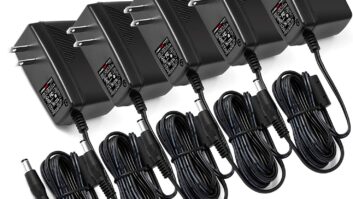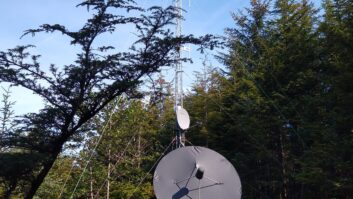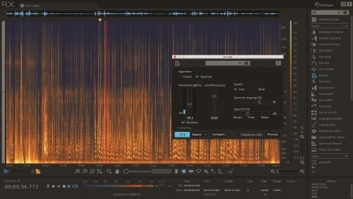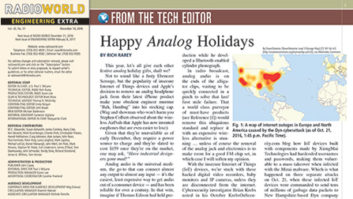(click thumbnail)Fig. 1: How many problems can you spot here?O. K., let’s start with a quiz. Refer to Figure 1, and see how many problems you can find.
We’ll provide a list later in the column.

. . .
Damian Centgraf is with WSHB Shortwave of the Herald Broadcasting Syndicate Inc. He needed to install some ground rods for their new antenna system. Rather than look for a ground-rod bit, he had great results by removing the bit and slipping the electric jackhammer over the top of the ground rod and pulling the trigger.
In addition to the rods installed for the antenna system, Damian and his crew sunk a rod at each fence post around the perimeter.
The job took only a couple of days with the electric jackhammer, vs. a couple of months with a sledgehammer.
. . .
(click thumbnail)Fig. 2: John Mullins and Ray Bass say goodbye to an old friend.Looking for a good intermediate step toward digital?
WWWJ(FM)’s John Mullins and Ray Bass retired their ITC triple deck, seen in Figure 2.
A pair of Sony MiniDisc machines now handle the spot load for theradio station in Galax, Va.
Afternoon personality Joel Bonn is seen using the machines in Figure 3 on page 20. Storage and organization of the disks was easy using an inexpensive computer floppy-disk carrier.

. . .
A few months back, there was a thread on Dave Biondi’s [email protected] list server discussing the most ingenious repairs.
Scott Johnson with Klotz Digital wrote about his contracting years. Specifically, he was at a client’s station doing some maintenance on a 5-kW transmitter. When they turned the transmitter back on, it wouldn’t come up.
The starter capacitor for the transmitter blower motor had failed. The air pressure interlock prevented the rig from coming back up because the motor was not spinning.
(click thumbnail)Fig. 3: Afternoon personality Joel Bonn uses MD machines at WWWJ(FM) in Galax, VA
There were no spares and no stores open. No one that Scott called had any spare caps, and Monday-morning drive was fast approaching. Faced with the prospect that the station would be dead until the parts houses opened at 9 a.m., Scott searched for a solution.
The answer came in the form of 10 feet or so of nylon cord. Scott opened the back door and wrapped the cord around the blower motor shaft. The GM stood in front of the transmitter, with his finger on the “ON” switch.
Scott yanked the cord hard, spinning the motor. He then slammed the transmitter door, and yelled, “Now!” to the GM, who hit the switch.
It took two tries, but the second time, Scott yanked hard enough that the motor spun fast enough to start when the power was applied.
The transmitter came up, and wasn’t turned off until the replacement capacitor was located.

. . .
Joey Helleny of Southern Illinois University Broadcasting Service sends in his favorite source for pre-made RF cables. Contact Cable X-perts at www.cableexperts.com.
The guys assemble low-loss coax cable assemblies for RPU use, and stock a variety of RF connectors and adapters.
. . .
Well, how did you do inspecting that AM tower picture?
Most obvious are the painted ball arc gaps. Ball gaps should be sanded smooth, polished, with no paint, so a static charge can easily jump the gap to ground.
The exposed radials will raise the eyebrow of an FCC inspector, and unless this station used scissors, I don’t know how they trimmed the grass without the risk of chewing up the radials.
A better idea would be to lay down some landscape fabric over a sand base, and cover the fabric with crushed stone. This will eliminate vegetation and provide some protection to the radial wires and the point they are soldered to the ring around the tower base.
Did you catch the paint on the base insulator? Paint can hide cracks and compromise the insulating characteristics of the porcelain. Just above the insulator, there is evidence of rusting under the painted surface of the base of the tower.
(click thumbnail)Fig. 4: This MiniDisc storage approach is nice and neat.
Keep weep holes clean, if used, and use a stiff wire brush to remove flaking paint. Flaking or bubbled paint can trap water, which will only destroy your tower.
If you want to get picky, a larger-width copper ground strap probably should be used. The strap in the picture was a little wider than 1 inch. That the arc gap balls are so black on the inside is indicative that they have worked bleeding some charge off the tower.
However, the extensive amount of burning may be that the gap is set too close. A static charge may start the arc, but high modulation may sustain it, with the burn over the large surface area the result. Always check the arc gap with heavy modulation, and at night, to watch for any flashover.
E-mail any other flaws you might have noticed to the address below.
Submissions for this column are encouraged, and qualify for SBE recertification credit. Fax your submission to (703) 323-8044, or send e-mail to[email protected].













